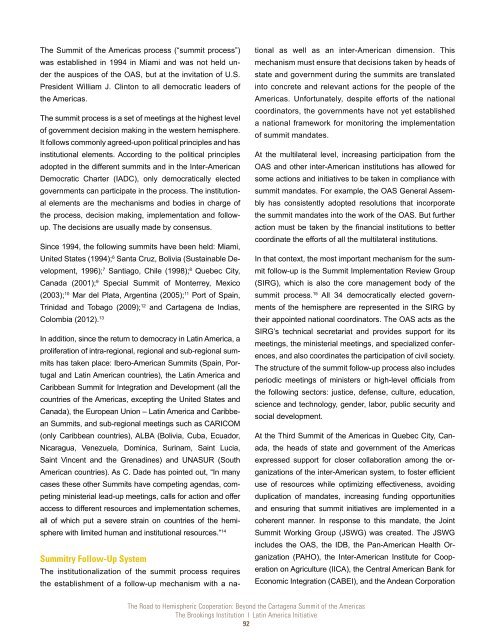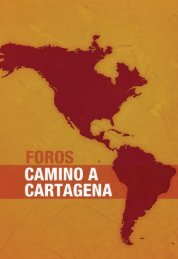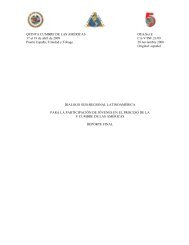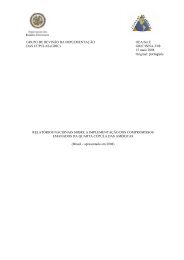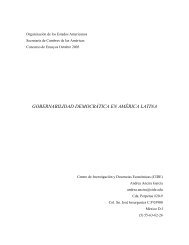The Road to Hemispheric Cooperation: Beyond the Cartagena
The Road to Hemispheric Cooperation: Beyond the Cartagena
The Road to Hemispheric Cooperation: Beyond the Cartagena
You also want an ePaper? Increase the reach of your titles
YUMPU automatically turns print PDFs into web optimized ePapers that Google loves.
<strong>The</strong> Summit of <strong>the</strong> Americas process (“summit process”)<br />
was established in 1994 in Miami and was not held under<br />
<strong>the</strong> auspices of <strong>the</strong> OAS, but at <strong>the</strong> invitation of U.S.<br />
President William J. Clin<strong>to</strong>n <strong>to</strong> all democratic leaders of<br />
<strong>the</strong> Americas.<br />
<strong>The</strong> summit process is a set of meetings at <strong>the</strong> highest level<br />
of government decision making in <strong>the</strong> western hemisphere.<br />
It follows commonly agreed-upon political principles and has<br />
institutional elements. According <strong>to</strong> <strong>the</strong> political principles<br />
adopted in <strong>the</strong> different summits and in <strong>the</strong> Inter-American<br />
Democratic Charter (IADC), only democratically elected<br />
governments can participate in <strong>the</strong> process. <strong>The</strong> institutional<br />
elements are <strong>the</strong> mechanisms and bodies in charge of<br />
<strong>the</strong> process, decision making, implementation and followup.<br />
<strong>The</strong> decisions are usually made by consensus.<br />
Since 1994, <strong>the</strong> following summits have been held: Miami,<br />
United States (1994); 6 Santa Cruz, Bolivia (Sustainable Development,<br />
1996); 7 Santiago, Chile (1998); 8 Quebec City,<br />
Canada (2001); 9 Special Summit of Monterrey, Mexico<br />
(2003); 10 Mar del Plata, Argentina (2005); 11 Port of Spain,<br />
Trinidad and Tobago (2009); 12 and <strong>Cartagena</strong> de Indias,<br />
Colombia (2012). 13<br />
In addition, since <strong>the</strong> return <strong>to</strong> democracy in Latin America, a<br />
proliferation of intra-regional, regional and sub-regional summits<br />
has taken place: Ibero-American Summits (Spain, Portugal<br />
and Latin American countries), <strong>the</strong> Latin America and<br />
Caribbean Summit for Integration and Development (all <strong>the</strong><br />
countries of <strong>the</strong> Americas, excepting <strong>the</strong> United States and<br />
Canada), <strong>the</strong> European Union – Latin America and Caribbean<br />
Summits, and sub-regional meetings such as CARICOM<br />
(only Caribbean countries), ALBA (Bolivia, Cuba, Ecuador,<br />
Nicaragua, Venezuela, Dominica, Surinam, Saint Lucia,<br />
Saint Vincent and <strong>the</strong> Grenadines) and UNASUR (South<br />
American countries). As C. Dade has pointed out, “In many<br />
cases <strong>the</strong>se o<strong>the</strong>r Summits have competing agendas, competing<br />
ministerial lead-up meetings, calls for action and offer<br />
access <strong>to</strong> different resources and implementation schemes,<br />
all of which put a severe strain on countries of <strong>the</strong> hemisphere<br />
with limited human and institutional resources.” 14<br />
Summitry follow-up System<br />
<strong>The</strong> institutionalization of <strong>the</strong> summit process requires<br />
<strong>the</strong> establishment of a follow-up mechanism with a na-<br />
tional as well as an inter-American dimension. This<br />
mechanism must ensure that decisions taken by heads of<br />
state and government during <strong>the</strong> summits are translated<br />
in<strong>to</strong> concrete and relevant actions for <strong>the</strong> people of <strong>the</strong><br />
Americas. Unfortunately, despite efforts of <strong>the</strong> national<br />
coordina<strong>to</strong>rs, <strong>the</strong> governments have not yet established<br />
a national framework for moni<strong>to</strong>ring <strong>the</strong> implementation<br />
of summit mandates.<br />
At <strong>the</strong> multilateral level, increasing participation from <strong>the</strong><br />
OAS and o<strong>the</strong>r inter-American institutions has allowed for<br />
some actions and initiatives <strong>to</strong> be taken in compliance with<br />
summit mandates. For example, <strong>the</strong> OAS General Assembly<br />
has consistently adopted resolutions that incorporate<br />
<strong>the</strong> summit mandates in<strong>to</strong> <strong>the</strong> work of <strong>the</strong> OAS. But fur<strong>the</strong>r<br />
action must be taken by <strong>the</strong> financial institutions <strong>to</strong> better<br />
coordinate <strong>the</strong> efforts of all <strong>the</strong> multilateral institutions.<br />
In that context, <strong>the</strong> most important mechanism for <strong>the</strong> summit<br />
follow-up is <strong>the</strong> Summit Implementation Review Group<br />
(SIRG), which is also <strong>the</strong> core management body of <strong>the</strong><br />
summit process. 15 All 34 democratically elected governments<br />
of <strong>the</strong> hemisphere are represented in <strong>the</strong> SIRG by<br />
<strong>the</strong>ir appointed national coordina<strong>to</strong>rs. <strong>The</strong> OAS acts as <strong>the</strong><br />
SIRG’s technical secretariat and provides support for its<br />
meetings, <strong>the</strong> ministerial meetings, and specialized conferences,<br />
and also coordinates <strong>the</strong> participation of civil society.<br />
<strong>The</strong> structure of <strong>the</strong> summit follow-up process also includes<br />
periodic meetings of ministers or high-level officials from<br />
<strong>the</strong> following sec<strong>to</strong>rs: justice, defense, culture, education,<br />
science and technology, gender, labor, public security and<br />
social development.<br />
At <strong>the</strong> Third Summit of <strong>the</strong> Americas in Quebec City, Canada,<br />
<strong>the</strong> heads of state and government of <strong>the</strong> Americas<br />
expressed support for closer collaboration among <strong>the</strong> organizations<br />
of <strong>the</strong> inter-American system, <strong>to</strong> foster efficient<br />
use of resources while optimizing effectiveness, avoiding<br />
duplication of mandates, increasing funding opportunities<br />
and ensuring that summit initiatives are implemented in a<br />
coherent manner. In response <strong>to</strong> this mandate, <strong>the</strong> Joint<br />
Summit Working Group (JSWG) was created. <strong>The</strong> JSWG<br />
includes <strong>the</strong> OAS, <strong>the</strong> IDB, <strong>the</strong> Pan-American Health Organization<br />
(PAHO), <strong>the</strong> Inter-American Institute for <strong>Cooperation</strong><br />
on Agriculture (IICA), <strong>the</strong> Central American Bank for<br />
Economic Integration (CABEI), and <strong>the</strong> Andean Corporation<br />
<strong>The</strong> <strong>Road</strong> <strong>to</strong> <strong>Hemispheric</strong> <strong>Cooperation</strong>: <strong>Beyond</strong> <strong>the</strong> <strong>Cartagena</strong> Summit of <strong>the</strong> Americas<br />
<strong>The</strong> Brookings Institution ❘ Latin America Initiative<br />
92


